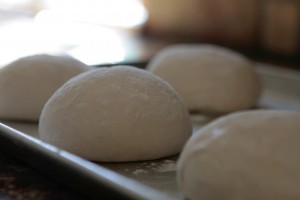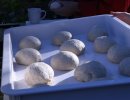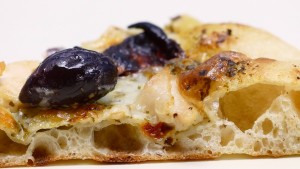Do’s and “Doughn’ts”
Ovens, ingredients, equipment, technique — these are vital components of the quest for great pizza. But, let’s face it, for most of us the real obsession, the “Golden Fleece,” and “Holy Grail” of pizza, is creating the perfect pizza crust.  The world’s best pizza makers, amateur or professional, are never satisfied with their dough. Even the most stubborn, set in their ways old school pizza makers will lean in when someone is speaking about pizza dough. I can’t think of a single culinary topic that draws as much discussion, debate and, at times, flat out anger as the combining of flour, water, salt, and yeast. In fact even something as simple as adding oil to the four basic elements can inspire both international affirmation and outrage.
The world’s best pizza makers, amateur or professional, are never satisfied with their dough. Even the most stubborn, set in their ways old school pizza makers will lean in when someone is speaking about pizza dough. I can’t think of a single culinary topic that draws as much discussion, debate and, at times, flat out anger as the combining of flour, water, salt, and yeast. In fact even something as simple as adding oil to the four basic elements can inspire both international affirmation and outrage.
So, if you are a member of the cult of pizza dough fanatics, or are about to dive in, how do you sort out all of the opinions, myths, and conflicting ideas.
Step one should be to clearly define exactly what your objective is. Write down the characteristics you would like your perfect dough to have. Is it soft? Pliable? Crispy? Bread-like? Cracker thin? Do you want an open crumb? What about flavor? Complex? Sweet? Acidic? Salty? Do you want to emphasize the flavors of the grain? Identify what you would like to achieve and it will become much easier to select the methods and ingredients that are right for you.
Step two, get a job in a bread bakery. Just kidding (sort of). Rome’s rock star pizza maker, Gabrielle Bonci, advises that every pizza maker should first spend 3 years as a baker. While that may not be possible for most of us the wisdom of his advice is evident. Bread bakers have a much deeper understanding of the process than the average old time pizza maker. Pre-ferments, autolyse, sprouted grains, custom flour blends, these have become standard tools in the arsenal of today’s pizza champions. It is absolutely vital that you understand how the choices you make in both ingredients and method will affect the finished product. If you haven’t read Peter Reinhart’s award winning bread book The Bread Bakers Apprentice, put it on your list. It will provide you with all of the information you need to bring your dough making skills to the next level.
Step 3: Throw away your measuring cups and spoons. If you are serious about making great dough consistently, then all the ingredients must be weighed. Buy a good digital scale and, while you are in the store, get yourself an accurate thermometer. Dough making is as much a science as it is an art. It’s all about time, temperature, formulas and, above all, control. Remember your seventh grade science class? No matter how good your dough is, at some point you are going to be tempted to tweak your formula. That’s good, it’s how progress is made. But remember: Never change more than one variable at a time. The only way you can control results and know for sure how each element is altering your dough is to maintain disciplined protocols. Learn to use Bakers Percentages and the Metric System. These components will enable you to extend or reduce recipes and give you complete control when you inevitably start to experiment with your formula.
Now for the part that is strictly my opinion based on collaboration with some of the worlds most acclaimed pizza makers and combined with my own very biased observations:
–The trend in pizza dough is towards long, cold fermentation. Of course, what constitutes long fermentation is highly subjective. Many Neapolitans consider 24 hours to be long. For the rest of us long fermentation is 48+ hours and I know some who will go as long as 6 days with a cold ferment. I usually prefer 72-96 hours for my American-style pizza.
–The use of pre-ferments and sours is all the rage and can be used to great advantage. However, unless you are trying to produce a distinctly sour pizza, I feel it is not necessary to add a biga or pre-ferment if you are using extended fermentation since, for all practical purposes, the entire batch of dough has developed complex flavor profiles over the 3-4 days. As a side note, I never put sugar in my pizza dough. Long fermentation will make the natural sugars in the wheat accessible.
–Many pizza makers are now using the autolyse method in their mix (short mixing without salt, followed by a 20-30 minute rest period, then add the salt and continue mixing). Without changing your formula this very simple method will improve the flavor and texture of most pizza dough formulas.
–Select the right flour for the job. Don’t try to make a crispy NY-style pizza using -00- Neapolitan flour in your home oven. That flour wasn’t designed for this and no amount of blending or manipulation is going to give you the result you want. Do your research and choose flours that were formulated by experts for the specific type of pizza you want to make.
–One of the most underappreciated components of dough is salt content. Too little and the dough is flat tasting. Too much and you cannot taste the wheat. Your starting point should be 2% with 2.5% being the sweet spot for most recipes. The exception is for wetter dough. If your hydration is approaching 70% or higher I suggest going up to 2.75 % salt or even closer to 3% for very wet dough.
–Yeast is yeast, or so some of my chemist friends tell me. Well, if that’s so why do the sours from different places taste so different? Why do brew masters use different strains of yeast for different types of beer. I use fresh yeast in my pizza dough. I may be dead wrong, but that’s what I like. The yeast I use is the same yeast that would be used to make a lager beer. My feeling is that there are underlying reasons why beer and pizza go together so well. The processes are related and, in the old days, schools that taught brewing also taught bread baking.
For now let’s conclude by circling back to the question of olive oil in pizza dough. Here’s the part where my friends from Naples disown me: I like it! Olive oil will flavor your dough, soften it, and create a barrier between the moisture of your sauce and toppings and the crumb structure of your crust. It is used in many Italian breads and focaccia and is common for pizza outside of Naples, so why not? Just be sure to add it into your mix after the dough has come together (usually about 4 minutes into the mix).
Above all I urge you to find joy in the spiritual alchemy of making dough. It is your personal quest. Learn all that you can. Master the fundamentals. Memorize all of the rules… and then discard them! 
As the great philosopher Van Morrison said “No teacher. No method. No guru….”
Recent Articles by John Arena
Comments
Add Comment
You must be logged in to post a comment.











Bravo!
Great article John
Nice article. I’ve studied bread science intently for 5 years, just as a hobby.
I baked my first loaf of bread when I was 60 years old. I bake all of my bread and pizza outdoors in my Ceramic oven, known as the Big Green Egg. Getting to 800° to bake Neapolitan style dough is no problem.
Knowing when to add your salt is critical. Salt & oil are gluten strand development inhibitors so giving your flour and water a head start on the gluten development process is wise.
Delayed fermentation to add flavor. You are absolutely correct on that topic. When I try a change to my pizza dough I mix up a batch that will give me 3-290 gram dough balls, 12″ pizza crusts. I’ll bake the first one after 48 hours in the fridge. The second one after 72 hours and the third after 96 hours just to sample the difference. Longer is better.?
Neapolitan dough blasphemy.? I make my dough using my sourdough starter. It improves the flavor.?
I received the link for your article from a fellow Pit member from the AmazingRibs.com website. Me and my backyard Pit Master are having a fun discussion about how to bake our Pizza’s outdoors on our ceramic ovens. All is good in our pizza world.?
Thanks Brian — great comments! Interesting that even after 96 hours (4 days) that your dough keeps getting better. At which point would you say it begins to break down or diminish? Do you think the dough would last as long if using commercial yeast instead of your natural starter?
I get a lot of interest in folks wanting to know how to bake bread in the Big Green egg. Any tricks you can share?
Would love to try your ‘cue one of these days! Whereabouts do you live and do you a preference as to which type of barbecue you prefer or are you like me, an omnicue kind of guy?